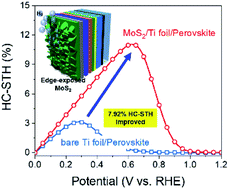An organometal halide perovskite photocathode integrated with a MoS2 catalyst for efficient and stable photoelectrochemical water splitting†
Abstract
Photoelectrochemical water splitting using organometal halide perovskites (OHPs) is an attractive and sustainable method for converting solar energy to hydrogen (H2). However, the poor stability of OHPs in aqueous electrolytes and the use of Pt, a noble metal, as a hydrogen evolution reaction (HER) catalyst restrict the practical application of OHP-based photocathodes. Herein, we report an efficient and stable OHP-based photocathode using Ti foil as the protective encapsulation layer and earth-abundant and cost-effective MoS2 as the HER catalyst. The fabricated MoS2/Ti foil/OHP photocathode presents a remarkable half-cell solar-to-hydrogen conversion efficiency of 11.07%, a photocurrent density of −20.6 mA cm−2 at 0 V versus the reversible hydrogen electrode (vs. RHE), and an onset potential of 1.02 V vs. RHE. Furthermore, the MoS2/Ti foil/OHP photocathode exhibits a record long-term PEC stability in aqueous electrolytes over 120 h of illumination. Our study provides insights into designing the structure of OHP-based photocathodes for efficient and stable solar H2 production.

- This article is part of the themed collection: Editor’s Choice: Perovskite-based solar cells


 Please wait while we load your content...
Please wait while we load your content...